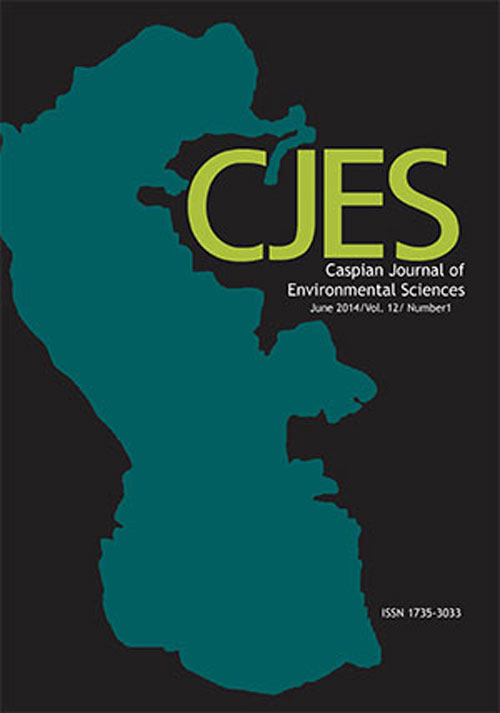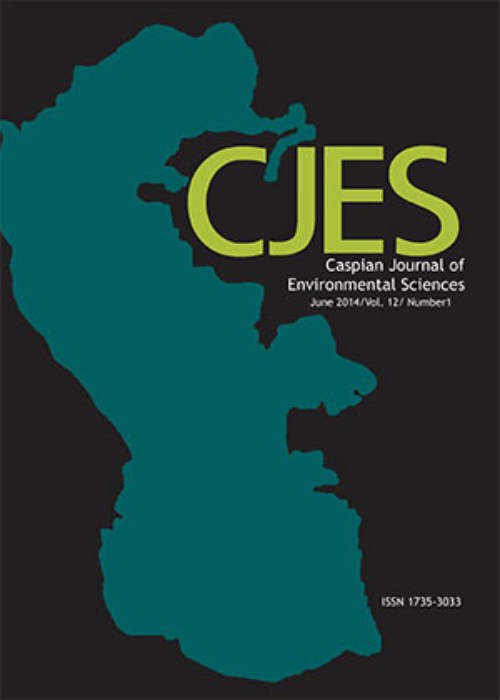فهرست مطالب

Caspian Journal of Environmental Sciences
Volume:16 Issue: 4, Autumn 2018
- تاریخ انتشار: 1397/12/01
- تعداد عناوین: 8
-
-
Pages 307-317This study aimed to evaluate some nutritional values and heavy metal contents of fishmeal produced by the commercial factories in Guilan Province, the Southwest Caspian Sea. The fishmeal samples were randomly collected from five factories producing fishmeal by Kilka (Clupeonella spp.) (units 1-4) and tuna canning offal (unit 5) as the raw materials. Proximate fish composition, amino acid contents and four heavy metal concentrations including chromium (Cr), cadmium (Cd), lead (Pb), and mercury (Hg) were measured in the fishmeal specimens. Crude protein contents were found to be in the range of 53.61-68.82% and the lowest value belonged to the unit 5. Also, the highest level of fat and ash contents were 22.49% and 18.05%, respectively (p < 0.05). The lowest essential: nonessential amino acid ratio was 0.71 in unit 5. Fishmeal specimens from unit 5 showed the highest metal concentrations with the following descending order: Cr > Cd > Pb > Hg. Results indicated that the heavy metal concentrations in the fishmeal are dependent on the source of raw materials.The heavy metal concentrations in the examined fishmeal did not exceed the permissible limits proposed by National Research Council (NRC) for animal feedstuff requirements.Keywords: Fishmeal, Kilka, Heavy metal, Amino acid composition, Caspian Sea
-
Pages 319-332This study aimed to investigate floristic and physiognomic characteristics of all plant species in relation to grazing and anthropogenic disturbances. So that, 100 ha beech communities were studied including 50 ha as protected and 50 ha as unprotected area of oriental beech communities in Masal forest, Guilan Province, Iran. The results indicated that the number of all species were higher in the protected area. The main family of the protected area was the Rosaceae, while in the unprotected area the Asteracea had the highest frequency. To identify and classify forest types in both areas, we used the proportion of each tree species larger than 7.5 cm in diameter to determine species dominance according to the classification method of Gorji Bahri. The applied tree classification method indicated that there were three main types and two secondary types in the protected area, whereas six main types were identified in the unprotected area. Physiognomic studies indicated that trees from both areas were in the same height classes, whereas, the total canopy cover percentage was higher in the protected area. Height classes and canopy cover percentage of deciduous broadleaf in shrub layer, were significantly higher in unprotected area than in protected one. In the latter area, the coverpercentage of herbaceous species was different. So that, forbs species had the highest coverpercentage. According to these results, destructive factors have altered the main composition in these communities. So that, avoid of livestock grazing and local people in these areas or livestock exclusion can be recommended as a management.Keywords: Composition, Destructive Factor, Forest Types, Hyrcanian Forest, Plant Physiognomy
-
Pages 333-347Nowadays, dust storms are an important environmental problem in Iran (especially in Khuzestan Province). The Hawr-al-Azim Wetland is a source for generation of dust storms. One-third area of this wetland is located in Iran. In this study, dust discharge is calculated using wind velocity, mean soil grain size (D50) and soil dry density. Soil characteristics were determined by data collected from 16 boreholes drilled in this wetland. Distributions of D50 and soil dry density in the wetland were determined using ordinary kriging method. Then critical wind speed was calculated in different regions of the wetland. The wetland soil is composed of medium and coarse silty soil. The dust mass discharge has reduced from 2003. The maximum monthly dust discharge mass occurs in June and July (along with a mean monthly wind velocity of 4.42 m s-1 and 4.27 m s-1, respectively). Because of the little amount of clay particles and the high wind velocity, increased soil moisture content cannot help in neither raise inthe critical shear velocity nor decreased dust mass discharge. Also, the produced dust is transported towards Northwest Iran because the dominant direction of wind is 270° to 300° relative to the north.Keywords: Critical shear velocity, Dust mass discharge, Soil moisture content, Hawr-al-Azim Wetland, Wind erosion
-
Pages 349-358Fisheries management receives assistance by prediction of events to evaluate fluctuating values for a target species to formulate proper policies and actions particularly for threatened and endangered species. This study aimed to predict 7 years Catch Per Unit Effort (CPUE) of kilka fishes as at-risk population in southern regions of the Caspian Sea. The former catch data from the Fisheries Organization of Iran (IFO) archives (1997 to 2014) were analyzed using ARIMA and SARIMA models. The data were divided into four parts (quarters) addressing one-fourth of a year to represent time and expressed as “Q”. According to periodic changes of ACF and PACF indices, seasonal ARIMA (SARIMA) models were used. The appropriate SARIMA models were examined using BIC, RMSE, R2, MSE and Ljung-Box indices. SARIMA (0, 1, 1) × (0, 1, 1) 4 process was the selected final model which met the criterion of model parsimony according to BIC of 31.91, RMSE of 7195193 , MAE of 4372178 , R2 of 0.82 and Ljung-Box index < 0.05. Based on selected SARIMA model, the forecasts indicated that if the fishing fleet and efforts remain at the present level, the performance of kilka fishing will likely have gentle rise by 2021.Keywords: SARIMA model, Kilka, Time series forecasting, Fishing effort, South Caspian Sea
-
Pages 359-367Lysozyme (N-acetylmuramide glyconohydrolase, (EC 3.2.1.17)) is a unique enzyme which cleaves the β-1,4 linkages of N-acetylmuramic and N-acetylglucosamine of the peptidoglycan, which leads to the lysis of the bacterial cell wall. Lysozyme, as a self-defense enzyme, is produced in many organs of vertebrates. The present study describes purification and characterization of lysozyme from Acipenser persicus (Borodin, 1897). After the extraction process, ion exchange chromatography was utilized to purify the enzyme. The SDS-PAGE analysis confirmed that the molecular weight was about 14 kDa. Moreover, some of the biochemical properties such as optimum temperature, pH and the effect of metal ions on the activity of purified enzyme were investigated. Based on the results the optimum activity and pH were obtained at 50 °C and 6.5 respectively. The purified lysozyme was active in the presence of different salts including NaCl (0–0.125 M), KCl (0.075–0.125 M), MgCl2, and CaCl2 (0.005 M). Kinetic parameters were also calculated.Keywords: Lysozyme, Acipenser persicus, Ion exchange chromatography, Metal ions, Optimum temperature, Catalytic efficiency
-
Pages 369-377Fire has an important role in destruction and negative side effects on forest ecosystem. The main aim of this study was to determine the main factors influencing the fire on set in Zarivar Lake forest area using remote sensing data, Geographic Information System (GIS) and Analytical Hierarchy Process (AHP) analysis. Vegetation density map derived from SPOT-HRG image data with 71.38% accuracy and 0.695 Kappa coefficients. The results of AHP analysis on destructive fire factors indicated that temperature and human-made factors had maximum influence on fire occurrence in the study area. Based on AHP analysis, final vulnerability map of study area was produced in Arc Map environment with 5 vulnerability areas. The results indicated that 78.03% of burned areas in 2009 and 2010 occurred in very high, high and moderate vulnerability area of final fire vulnerability map. So, this map can be used in forest management of Zarivar Lake area in dry season.
-
Pages 379-394Forests play a significant role for human’s well-being. Economists’ attention is mostly drawn on the market value of forest products. The trend, however, is changing as non-market values of forests are increasingly appreciated and measured. Recently, the ecosystem value of forest has been studied by natural resource economists and its role on human welfare is ensured. This paper indicates that the annual use value of the ecosystem services such as water conservation, soil protection, carbon fixation, nutrient cycling, water purification, air pollution absorption and recreation provided by forests is not only worth millions of dollars, but also in per hectare terms much more than hitherto known. This value for the Mazandaran forest reserve (MFR) ranged US$ 14.2–14.8 million or about US$ 6676.9–6785.6 per ha. If these are accounted for, then governments and societies faced with the development versus conservation dilemma can create more understanding decisions and policies that will assist conserve forests and the ecosystem services they provide, and thereby promulgate human well-being and sustainable development. Realization about these significant intangible benefits will assist in more informed decisions and policies that will help conserve forest ecosystems and the services they provide as well as promote human well-being and sustainable development.Keywords: Economic valuation, Forest ecosystem services, Sustainable development, Mazandaran forest reserve
-
Pages 395-404A total of 148 specimens of Capoeta trutta caught from Azad Dam Lake, Kurdistan Province, northwest of Iran were examined during 2015-2016 for assessing growth parameters. The total length (TL) and weight (W) of C. trutta ranged from 4.0 to 29.0 cm and 0.9 to 274.0 g, average (± SD) = 19.3 (± 4.0) cm and 80.3 (± 44.7) g, respectively. The length-weight regression was W = 0.0121 × TL2.9317 indicating isometric growth. The sex ratio (M:F) was 1:0.33, differed significantly from the expected 1:1 (P < 0.001). The von Bertalanffy growth parameters were estimated as L∞ = 29.6 mm, K = 0.33 yr-1, t0 = -0.57 yr. The instantaneous coefficient of natural mortality was estimated as 0.58 yr-1. The averaged condition factor (KF) was 1.00 ± 0.11, by significantly differences among seasons (P < 0.001). In the present study, the relative condition factor (Kn) of C. trutta were close to 1 suggesting the well-being condition of the fish in Azad Dam region.Keywords: Growth parameters, Condition factor, Capoeta trutta, Azad Dam, Iran


